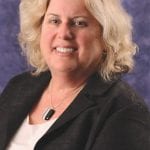Back to Normal?
It’s hard to gauge what ‘normal’ looks like during the era of COVID-19, when normalcy is a moving target. For area colleges and universities, though, getting back to normal means one thing: bringing as many students back to dorms and classrooms as possible. Make no mistake, campus life this fall will still be different from the pre-pandemic college experience, but just opening those classroom and residence-hall doors is a big step — the result of many lessons learned during the most unusual academic year in memory.

Normalcy.
It’s an attractive concept these days, if an elusive one. Just ask the folks planning for the fall 2021 semester at the region’s colleges and universities.
“This fall, we’ll go back to some normalcy, with classes back in person full-time, students in the residence halls, and athletes on the fields,” said Jonathan Scully, vice president of Enrollment Management and Marketing at Elms College. “That’s the plan right now.”
Scully said Elms has long maintained a COVID-19 task force that meets every week to discuss public-health data, on-campus health metrics, current recommendations of the CDC and the state Department of Public Health, and, importantly, how faculty and staff feel about a full return. “That all played a part in making decisions for the fall.”
He noted that students seem excited about coming back to Springfield Street in Chicopee, even though the college’s ElmsFlex hybrid plan, by which students could learn on campus, remotely, or with a combination of both, has been well-received.
“We’re not fully remote; we had that ElmsFlex option, because some students learn better in person, and some did better virtually, and they had the ability to move between the two freely,” Scully said. “But everyone is looking forward to a return to normalcy.”
Western New England University (WNEU) was among just 27% of U.S. colleges and universities that opened to mainly in-person learning and residential living last fall and remained open through the 2020-21 year, having delivered about 75% of courses on campus and the rest through online and hybrid formats, said Bryan Gross, vice president of Enrollment Management and Marketing.

Jonathan Scully
“Because some students learn better in person, and some did better virtually, and they had the ability to move between the two freely. But everyone is looking forward to a return to normalcy.”
Two factors played into that success, he said: a culture of small class sizes (the average student-teacher ratio is 12:1) and plenty of space that made social distancing much easier to implement, and a commitment — a compact, really, among students, faculty, and staff — to make sure the campus could stay open.
“They adhered to that social distancing, we put up tons of signage, we brought in extra cleaning staff, we had plexiglass throughout … all those things contributed to the plan for the past year,” Gross told BusinessWest.
He noted that colleges and universities don’t have the luxury of making their fall opening plans in July or August; the shift on the fly to remote learning that happened last spring is not the preferred model for campus planning. So, while the course of the pandemic might still alter the plans before September, those plans still need to be made and set in motion.
At WNEU, that will mean all courses normally taught on campus will be, indeed, taught in person, with three-foot distancing in place and masks required, at least according to current guidance. While some hybrid options may be available, Gross said, “we feel Western New England is best with face-to-face classwork, and that’s what we’re moving forward with.”
American International College (AIC) is moving in that direction as well, said Matt Scott, vice president for Student Affairs.
For the current year, he explained, residence halls are open, and students are allowed to live on campus, but most classes are remote, and athletics have continued as normal. Surveillance testing for COVID is widespread, and other safety and sanitization protocols are a regular part of life.
For the fall, Scott said, the current plan is to go back to “whatever the new normal will look like,” but the goal being full residence halls and in-person instruction.
“We’re still waiting to see some state guidance — there’s K-12 guidance that came out in terms of desk distancing in classrooms and things of that nature, but they have not come out with specific guidance for colleges yet,” he added. “But that’s the plan.”

Chet Jordan
“Safety on our campus is paramount; one of the biggest considerations in our return to campus is how to utilize our space safely.”
The plan at most campuses, it turns out, is for normalcy, or, as Gross noted, whatever that term might mean come September. But optimism is high that college life will finally begin to look like it used to.
Safety First
Community colleges, for the most part, were more fully remote than most schools, and are being more cautious with their return to normalcy. For example, Greenfield Community College (GCC) will offer classes in a face-to-face or hybrid format, meeting at least once a week on campus with some possible online instruction as well.
“Safety on our campus is paramount; one of the biggest considerations in our return to campus is how to utilize our space safely,” said Chet Jordan, dean of Social Sciences and Professional Studies at GCC. “Our faculty and staff have been almost entirely remote for the past year, so their input in how we can phase in a slow reopening of the campus was essential to us.”
GCC brought together a group of faculty, staff, and administrators to talk through the complexities of a reopening, eventually crafting a hybrid model. “We want to make sure our faculty and staff feel safe when they return to campus,” Jordan added. “The situation is constantly changing, but we addressed the key questions as best we could.”
Students in GCC’s health-career programs will meet on campus in hands-on courses to best prepare them for essential jobs in the growing healthcare industry. Those in other professional programs, such as business and education, will also have on-campus options. In most programs, students will complete some of their coursework online and will participate in weekly experiential learning opportunities, including lab activities and field trips.
GCC will follow state guidelines on occupancy rates in classrooms and offices, mask requirements, and health screenings, as well as maintaining scrupulous air-quality practices and a thorough sanitizing schedule.
The class schedule is roughly 55% online and 45% in person, Jordan said, which allows time to space out the classes between sections to avoid a bottleneck of students entering and exiting, while maintaining appropriate distancing.
“It gives students who want to be on campus that in-person experience, but also flexibility the rest of the week to finish online,” he said, adding that the library will be available for students to access a virtual class between in-person sessions on any given day. “So they won’t have to jump between campus and home, we’re giving them space to do a remote class and then go to their next class on campus.”

Bryan Gross
“The long and short of it is, we’re hopeful to have a more normal, on-the-ground campus experience for our students and families.”
UMass Amherst also expects campus life to return to normal operations in fall 2021. That means an emphasis on face-to-face instruction, full residence halls — an expected 13,000 students will live on campus — and a complement of student events and activities.
Planning for summer orientation is well underway, as new students will be invited to participate in a series of synchronous and asynchronous orientation programs over the summer before they arrive for in-person welcome sessions at the end of August.
This past fall, many first-year students who would have experienced on-campus housing for the first time did not get that opportunity. So, in an effort to support these students, freshmen and sophomores will receive priority consideration to select on-campus spaces this fall. Still, based on current interest, UMass expects to be able to meet all housing requests, including all interested juniors and seniors.
Finally, UMass announced that its renovated Student Union is now open, offering space for events, student organizations, student businesses, and a ballroom.
The campus experience is more than academics, WNEU’s Gross said, noting that the university creative in finding ways to bring students together for small-group activities in the campus center. This fall, he expects larger outdoor activities, including intramural sports, to return, as well as indoor events as long as safety protocols are followed.
“The long and short of it is, we’re hopeful to have a more normal, on-the-ground campus experience for our students and families,” he said, including a big homecoming event inviting back the 2020 graduates, who were unable to have a traditional commencement experience.
Learning by Doing
In his first year working at GCC, Jordan said he has been “incredibly warmed and inspired by the creativity of the faculty, who do anything they can do make sure students have the best experience.”
For example, science classes have included more outdoor, experiential learning. Meanwhile, students in the health sciences have been on campus throughout the pandemic, due to the unique, hands-on needs of their training. “They paved the way,” he said. “They’re the ones who figured out how to open as safely as we possibly can.”
At AIC, students in those fields have been diligent about safety protocols and personal protective equipment, Scott said. “Because they’re health-science students, they tend to take it a little further than some of our other students. If they’re getting up close and personal, they’re wearing face shields and masks and such.”
Particularly during the 2020, he noted, constant pivoting was the order of the day for college faculty and administrators, who had to constantly monitor the development of the pandemic and guide a testing and safety plan for their campuses.
“But I think, overall, our plan stayed the same,” he added. “We thought it was safest this year to keep as many students remote as possible and have some in-person experiences that are kind of controlled for the pandemic-related protocols we had in place. That all stayed the same throughout the year, but the way we approached them adjusted as we needed to.”
Some of the lessons learned led to positive developments, said Kerry Cole, vice president for Admissions at AIC. For example, the college used to deliver its certificate of advanced graduate study (CAGS) programs for teachers at 11 physical sites. Once the program was forced online by COVID, administrators began to hear from the grad students that they loved it.
“So, beginning in the fall, we’re moving to a virtual format throughout the state, where we’re able to deliver licensing programs in a virtual format for all the programs we offer,” Cole said. “That came directly from students. They wanted virtual — not online, but virtual, synchronous, so they can communicate with each other.
“We’re very, very excited about it,” she went on. “Our teachers now need more flexibility than ever. They’re rock stars, and we need to be able to support them.”
Scott agreed, noting that there were many instances where he and others said, “wow, we didn’t realize this would work, that students would enjoy this.” One example is online counseling services, which are now much more accessible to commuter students.
That doesn’t mean students don’t want to return to in-person learning, of course; for the most part, they certainly do. But they’ve handled an unusual year well, he said.
“I am amazed every day how well our students are doing with these protocols. You’ll always have the occasional mask below the nose, and that’s going to happen, usually because they have a mask that doesn’t fit them well. But we have not really had any issues with students giving people a hard time when they’re entering the dining commons to get food. We planned for that; we asked, ‘how are we going to deal with the student who shows up and flat-out refuses to wear a mask?’ But we have not had that happen.”
In fact, the worst incidents have been the occasional group of students who head to the mall and don’t wear masks in the car.
“They’re not supposed to do it, but there are far worse things they could be doing and far worse ways they could be violating our protocols,” Scott said. “We try not to have a heavy hand; we try to take an educational approach and make sure they understand the potential impact, the ripple effect those actions can have on the community. But we’ve been very impressed with the way our students have responded this year.”
Waiting for the Return
Enrollment dipped last year at many colleges due to uncertainty about what the academic experience and college life would entail, but most area institutions see the application and enrollment numbers on the rise in 2021.
“Along with the rest of the community-college sector, we saw a decline over the past year, but that was an anomaly,” Jordan said. “In most recessions, community colleges do really well, but this was the reverse; this sector was the hardest-hit. The reason is that low-income students and students of color have been unprecedentedly hit by this pandemic, and those are our students.”
It’s especially important, then, for community colleges to offer a flexible model during these times, and that’s what GCC is aiming for, he added.
“We want to be sure we’re reaching students at home with kids, so those students can take classes online, and also opening the campus in such a way that students who need to be on campus will get that in-person instruction. Having more flexible classroom options will invite more people back.”
Cole said AIC successfully implemented the plan it thought best for 2020-21, and will now expand upon that.
“We’re very excited about it,” she said, noting that campus tours have begun again, and the campus hosted its first in-person admissions event of the school year in mid-April. “Graduate students love virtual info sessions and open houses. Undergrads are a mixed bag, but graduate students will take it all day. So we’ll likely keep some of that.”
Scully said nothing is set in stone when it comes to pandemic planning; the past 13 months at the Elms have been proof of that.
“We’re monitoring everything very closely, and our first priority is the safety of students and staff,” he said. “We know things could change on a dime.”
Elms, like many colleges, already offered some programs online before the pandemic, and has since bolstered the technology to conduct those, having purchased new cameras, microphones, and other equipment. “But, like everyone else, we’re looking forward to getting back to normal.”
And doing so safely, Gross said.
“I’ve never been so proud to be part of an organization as I’ve been of our students, faculty, and staff over the last year and a half,” he said. “I can’t stress how many extra hours our faculty and staff put into adjusting curriculum, adjusting extracurriculars, and changing everything we do, from open houses to the way we engage with current students, prospective students, and alumni. It was a group effort in flexibility, agility, determination, and energy.
That said, “the community is tired,” he went on. “We’ve been going non-stop; I can’t tell you how many faculty and staff have told me about the extra hours they’ve put in over the weekends. We’ve all been chipping in to do whatever it takes to keep things safe and enjoyable for students.”
But there’s no time to take a break. Not with the fall semester right around the corner.
“Things are constantly changing,” Gross said. “We’re all learning as we go. But we are a learning organization, after all.”
Joseph Bednar can be reached at [email protected]








 “Someone develops Alzheimer’s disease every 68 seconds, with 5 million Americans affected, and the number expected to increase to 20 million by 2050.”
“Someone develops Alzheimer’s disease every 68 seconds, with 5 million Americans affected, and the number expected to increase to 20 million by 2050.”

